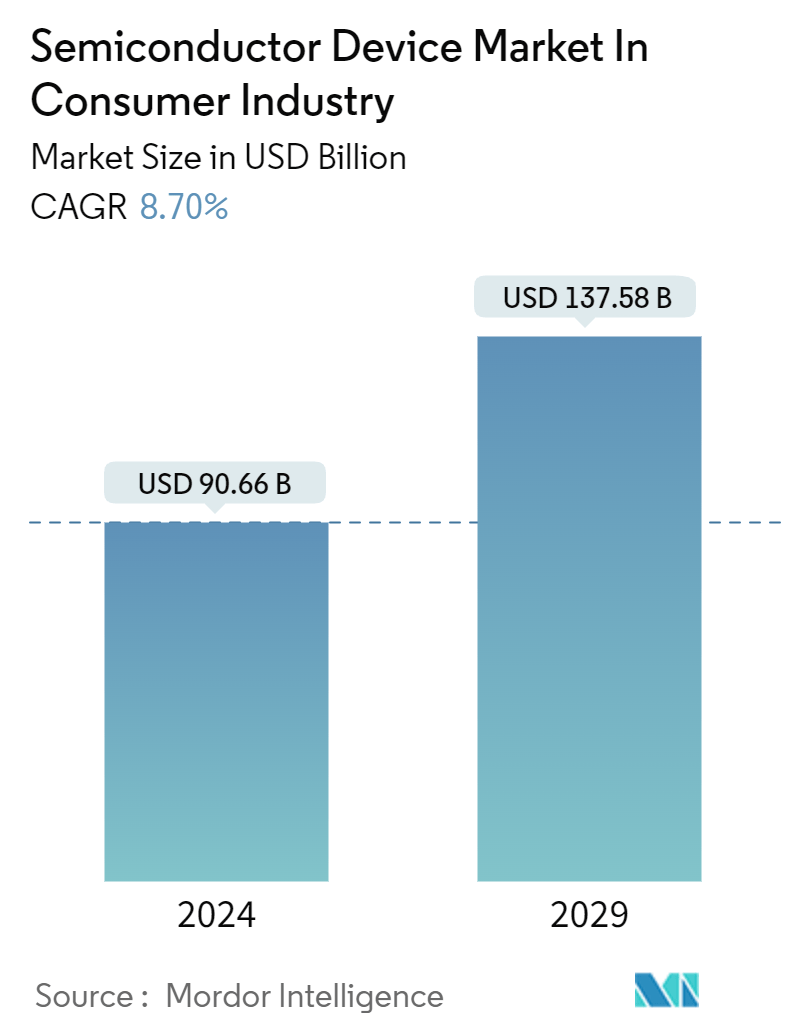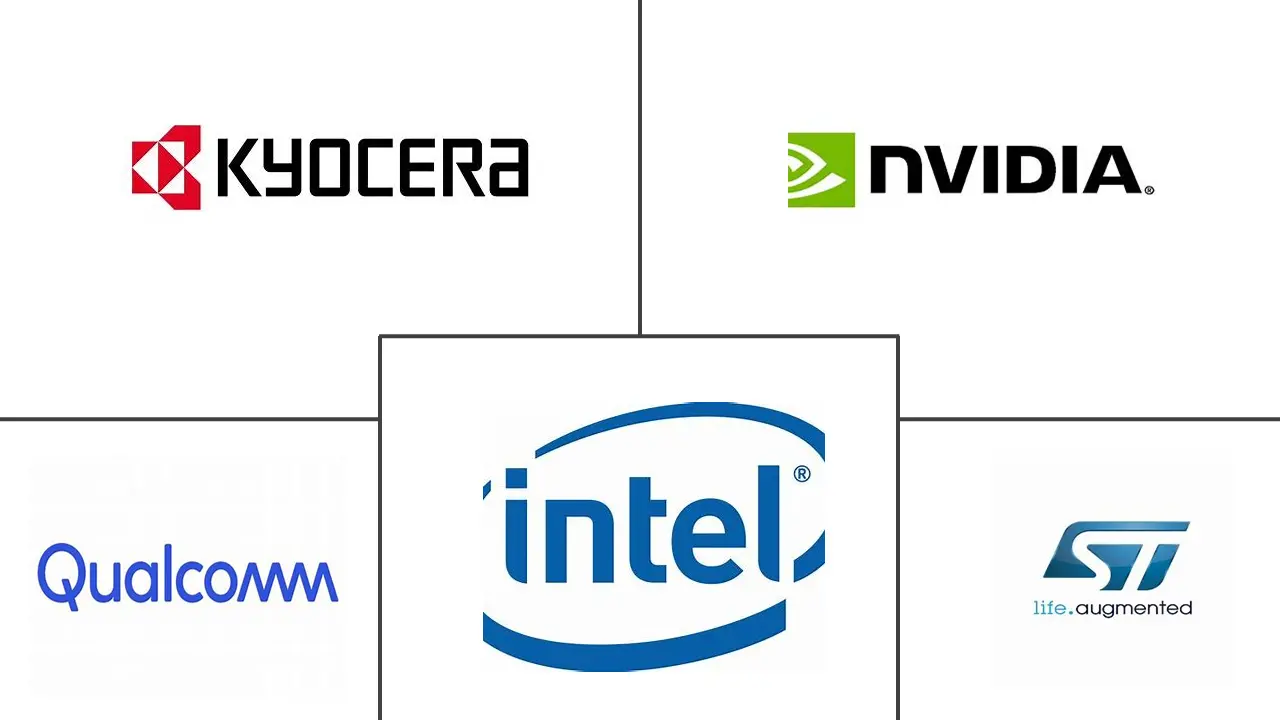Market Size of Semiconductor Device Industry In Consumer Industry

| Study Period | 2019 - 2029 |
| Market Size (2024) | USD 90.66 Billion |
| Market Size (2029) | USD 137.58 Billion |
| CAGR (2024 - 2029) | 8.70 % |
| Fastest Growing Market | Asia Pacific |
| Largest Market | Asia Pacific |
Major Players*Disclaimer: Major Players sorted in no particular order |
Semiconductor Device Market Analysis
The Semiconductor Device Market In Consumer Industry is expected to grow from USD 90.66 billion in 2024 to USD 137.58 billion by 2029, at a CAGR of 8.70% during the forecast period (2024-2029).
The semiconductor device market in the consumer industry was valued at USD 83.4 billion in the current year and is expected to register a CAGR of 8.7%, reaching USD 126.9 billion over the forecast period.
- Most consumer electronics, like mobile phones, laptops, game consoles, microwaves, and refrigerators, operate with semiconductors, such as integrated chips, diodes, and transistors. The high demand for these devices is a key factor contributing to the market growth.
- The use of integrated circuits is widespread in consumer electronics with microprocessor control, from cell phones and portable music players to gaming systems, PCs, and other digital devices. An integrated circuit (IC) or chip is an extremely sophisticated device that packs up many electronic components like capacitors, transistors, and resistors into an area of a few square centimeters on a silicon wafer.
- Further, the emergence of trends, such as consumer Internet of Things (IoT), has fueled the demand for the semiconductor devices market in the consumer industry. An ideal example of consumer IoT is the smart home, where electronic equipment, lighting, HVAC systems, and appliances are all controlled and monitored from a central hub. IoT applications cannot work without integrated circuits and sensors, so all IoT devices require semiconductors, which creates a huge growth potential for the market studied.
- Moreover, the explosive growth of smartphones and smart home devices in the markets in recent years has fueled the demand for the semiconductor device market in the consumer industry. The increasing adoption of the fifth-generation (5G) wireless technology for digital devices is also one of the major contributing factors to the rising demand for connected devices and smart products, thereby supporting the market's growth.
- The Russia and Ukraine war negatively impacted the supply chain in the semiconductor Industry. According to SEMI, Ukraine and China supply about 80% of Xenon and krypton gasses. These gasses are highly used in semiconductor manufacturing, and they can be obtained mainly through steel manufacturing and with the help of Air Separation units.
- With the war in place and no dedicated Air Separation Units elsewhere, the lead time for semiconductor manufacturing is increasing, leading to chip shortages across the industries studied.
Semiconductor Device Industry Segmentation
A semiconductor device is an electronic component made from semiconductor materials like silicon. It exhibits variable electrical conductivity, enabling control and manipulation of electrical currents. Common semiconductor devices include transistors, diodes, and integrated circuits. These devices are fundamental in modern electronics, serving functions like signal amplification, switching, and signal processing. They form the core of microchips, enabling the operation of computers, smartphones, and countless other electronic devices, making them integral to the functioning of our technologically driven world.
The semiconductor device market in the consumer industry is divided into various segments, including discrete semiconductors, optoelectronics, sensors, and integrated circuits (analog, logic, memory, and micro (microprocessors, microcontrollers, and digital signal processors)). This market analysis encompasses regions such as the United States, Europe, Japan, China, Korea, Taiwan, and the Rest of the World.
Market sizes and future predictions are expressed in terms of monetary value (USD) for each of these segments.
| By Device Type | ||||||||||
| Discrete Semiconductors | ||||||||||
| Optoelectronics | ||||||||||
| Sensors | ||||||||||
|
| By Geography | |
| United States | |
| Europe | |
| Japan | |
| China | |
| Korea | |
| Taiwan |
Semiconductor Device Market In Consumer Industry Size Summary
The semiconductor device market within the consumer industry is poised for substantial growth, driven by the increasing integration of semiconductors in a wide array of consumer electronics such as smartphones, laptops, and smart home devices. The proliferation of the Internet of Things (IoT) and the adoption of 5G technology are significant factors propelling this market expansion. As consumer electronics become more interconnected and intelligent, the demand for advanced semiconductor components like integrated circuits and sensors is expected to rise. This trend is further supported by the growing smartphone penetration and the need for energy-efficient smart home solutions, particularly in developing regions. The market's growth trajectory is also influenced by geopolitical factors, such as supply chain disruptions caused by the Russia-Ukraine conflict, which have led to chip shortages and increased manufacturing lead times.
The Asia-Pacific region is anticipated to dominate the semiconductor device market in the consumer industry, fueled by the presence of major consumer electronics manufacturers and favorable demographic trends. The region's expanding consumer market, characterized by rising disposable incomes and increasing demand for smart devices, is a key driver of market growth. Companies are actively investing in new technologies and expanding their operations to maintain a competitive edge. The market is characterized by intense competition among established players like Intel, Nvidia, and Qualcomm, who are focusing on innovation and performance to differentiate their offerings. Strategic partnerships and product launches, such as those by STMicroelectronics and Texas Instruments, highlight the industry's commitment to advancing semiconductor technology for diverse applications, including consumer electronics and IoT devices.
Semiconductor Device Market In Consumer Industry Market Size - Table of Contents
-
1. MARKET INSIGHTS
-
1.1 Market Overview
-
1.2 Industry Value Chain Analysis
-
1.3 Industry Attractiveness - Porter's Five Forces Analysis
-
1.3.1 Bargaining Power of Suppliers
-
1.3.2 Bargaining Power of Consumers
-
1.3.3 Threat of New Entrants
-
1.3.4 Threat of Substitute Products
-
1.3.5 Intensity of Competitive Rivalry
-
-
1.4 Impact of Macro Trends on the Industry
-
-
2. MARKET SEGMENTATION
-
2.1 By Device Type
-
2.1.1 Discrete Semiconductors
-
2.1.2 Optoelectronics
-
2.1.3 Sensors
-
2.1.4 Integrated Circuits
-
2.1.4.1 Analog
-
2.1.4.2 Logic
-
2.1.4.3 Memory
-
2.1.4.4 Micro
-
2.1.4.4.1 Microprocessors (MPU)
-
2.1.4.4.2 Microcontrollers (MCU)
-
2.1.4.4.3 Digital Signal Processor
-
-
-
-
2.2 By Geography
-
2.2.1 United States
-
2.2.2 Europe
-
2.2.3 Japan
-
2.2.4 China
-
2.2.5 Korea
-
2.2.6 Taiwan
-
-
Semiconductor Device Market In Consumer Industry Market Size FAQs
How big is the Semiconductor Device Market In Consumer Industry?
The Semiconductor Device Market In Consumer Industry size is expected to reach USD 90.66 billion in 2024 and grow at a CAGR of 8.70% to reach USD 137.58 billion by 2029.
What is the current Semiconductor Device Market In Consumer Industry size?
In 2024, the Semiconductor Device Market In Consumer Industry size is expected to reach USD 90.66 billion.


